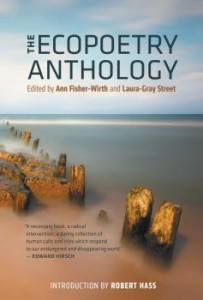 That’s what co-editor, Ann Fisher-Wirth, said in her introduction to this massive collection of “ecopoetry” by over 200 poets, both historial and contemporary. Wirth, who grew up in California but now lives in Oxford, Mississippi, says that poetry has “the power to move the world—to break through our dulled disregard, our carelessness, our despair, reawakening our sense of the vitality and beauty of nature.” She took on The Ecopoetry Anthology—a five-year project that would become a 576-page anthology–while teaching poetry and directing the environmental studies minor at the University of Mississippi.
That’s what co-editor, Ann Fisher-Wirth, said in her introduction to this massive collection of “ecopoetry” by over 200 poets, both historial and contemporary. Wirth, who grew up in California but now lives in Oxford, Mississippi, says that poetry has “the power to move the world—to break through our dulled disregard, our carelessness, our despair, reawakening our sense of the vitality and beauty of nature.” She took on The Ecopoetry Anthology—a five-year project that would become a 576-page anthology–while teaching poetry and directing the environmental studies minor at the University of Mississippi.

Wirth calls Mississippi “a place of both great beauty and severe environmental damage.” I met Ann a few years ago when she gave a craft talk during the Yoknapatawpha Summer Writers Workshop. And then in November of 2009 I enjoyed her reading from Five Terraces one night, and we’ve been friends ever since.
A few of my favorite poets are included in the anthology. Like Emily Dickinson, who writes in #537:
The bell within the steeple wild
The flying tidings told—
How much can come
And much can go,
And yet abide the world!
Robert Frost writes about the importance of being versed in country things, and e.e. cummings writes about finding a poisoned mouse.
And then there are the contemporary poets, like Stephen Cushman (I haven’t discovered whether or not he’s related to my husband) who writes about the rain in Maine, and Lola Haskins, whose “Prayer for the Everglades” ends with this question:
Oh what if? Look up, friend, and take my
hand. What if the wood storks were gone?
Treasures abound in this rich anthology published by Trinity University Press. Wirth’s co-editor is Laura-Gray Street and Robert Hass contributes an inspired introduction. But don’t take my word for it. Buy the book and enjoy the poetry yourself. But don’t expect it to be a quiet, relaxing read. Prepare to be challenged and to see the world in a different light.